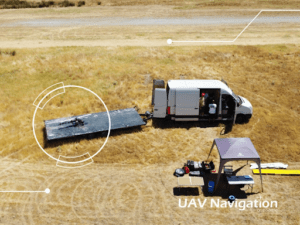 UAV Navigation Introduces Fully Automatic Landing on Moving Platforms for Maritime Operations
UAV Navigation Introduces Fully Automatic Landing on Moving Platforms for Maritime Operations
by DRONELIFE Staff Writer Ian M. Crosby
Flight control solutions specialist UAV Navigation has incorporated fully automatic flight deck UAV operations into its flight control system, enabling Unmanned Aerial Systems (UAS) to autonomously land on moving platforms.
The system’s autopilot is now capable of conducting fully autonomous maritime operations without any manual input across all stages of flight, from take-off to landing. The enhanced flight control system is able to carry out missions from vessels underway at sea or from moving platforms, all without the addition of any extra hardware or third-party devices to improve system capabilities. The UAV Navigation flight controller is able to complete the entire mission on its own, lightening operator workload significantly.
The autopilots’ VECTOR range features referenced navigation capabilities enabling the system to pursue a moving landing site to carry out a precise automatic landing under dynamic conditions. The system is able to control a safe touchdown even in conditions as poor as Sea State 4.
Flight tests saw the system conduct a fully autonomous landing on a moving platform traveling at a speed of up to 30 km/h or 16 knots, a speed typical of the variety of vessel being simulated. UAV Navigation places a great degree of value in the process of flight testing when incorporating new features such as this one. Flight control algorithms must undergo rigorous testing when facing the exertion of maneuvers of this kind.
Unmanned Aerial Systems (UAS) have the potential to offer major support for coast guard operations, such as maritime safety and security, fisheries control and law enforcement. The systems’ airborne perspective also grants a broader viewpoint for the detection of oil spills or sulfur emissions. Uncrewed Aerial Vehicles (UAVs) are already employed by governments and agencies such as the European Maritime Safety Agency (EMSA) for some of these use cases.
Already proven for maritime environments, UAV Navigation’s system possesses MIL-STD-810F and MIL-STD-461 qualifications, having undergone an intensive salt spray test, electromagnetic compatibility tests and RF shielding tests to guarantee continued operation within the chaotic environments found onboard large vessels.
Read more about automated drone landing systems:
- Spright and Wonder Robotics Team on Drone Landing Logistics for Medical Delivery
- Welcome to WonderLand: Wonder Robotics Scores Seed Funding for Drone Equipment that Clears the Way for Landing
- Unattended Drones: Heisha Makes Major Breakthrough in Precision Landing and Data Communication Range
- Precision Landing for DJI Drones: New Automation Solution from FlytBase
Ian attended Dominican University of California, where he received a BA in English in 2019. With a lifelong passion for writing and storytelling and a keen interest in technology, he is now contributing to DroneLife as a staff writer.

Miriam McNabb is the Editor-in-Chief of DRONELIFE and CEO of JobForDrones, a professional drone services marketplace, and a fascinated observer of the emerging drone industry and the regulatory environment for drones. Miriam has penned over 3,000 articles focused on the commercial drone space and is an international speaker and recognized figure in the industry. Miriam has a degree from the University of Chicago and over 20 years of experience in high tech sales and marketing for new technologies.
For drone industry consulting or writing, Email Miriam.
TWITTER:@spaldingbarker
Subscribe to DroneLife here.







[…] Source link […]